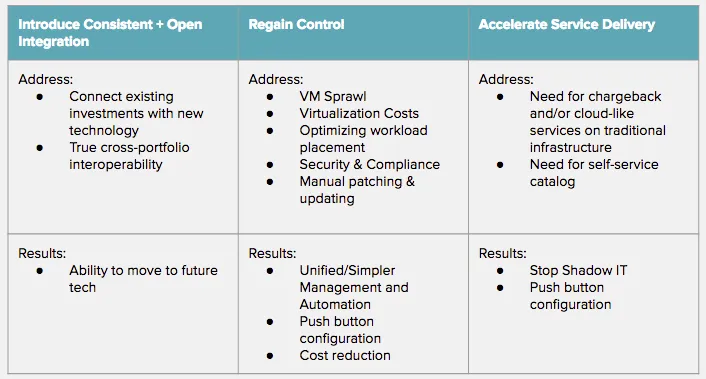Virtualization remains, and, I believe, will remain, an integral part of the modern datacenter for the next several years. According to the Uptime Institute, up to 65 percent of workloads are still on premise. And while virtualized workloads may give way to the cloud, it still puts virtualization in specific focus as a technology piece that needs to be modernized. Modern virtualization can provide a means to innovate, streamline, and optimize the infrastructure. Modernizing your virtualization can help to pull you out of the following negative cycle:

A lack of automation and standardization frequently contributes to issues with patching and security, while shadow IT often arises from a lack of services or a poor rate of service. Additionally, the complexity of the environment coupled with the previous issues can lead to “survival mode.” “Survival mode can then feed back into inability to innovate and the negative cycle can begin anew.
To help break out of this circle, it’s not so much a case of “more tools” as it is “different tools.” More specifically, modern tools.
For example, simply deploying a virtualization platform on its own can only solve a few problems.Deploying a virtualization platform that can integrate more easily with management, automation and other tools and investments, however, helps to solve broader problems and can provide a path to modern virtualization. Such is the case with Red Hat Virtualization, Red Hat CloudForms and Ansible, respectively.
To be perfectly clear, much of this modernization can include migrating from another virtualization platform to Red Hat Virtualization. I’d like to highlight three primary areas that can specifically address modernizing virtualization and how this can help you to realize the listed results:

-
Introduce more consistent and open integration - This is really about introducing Red Hat Virtualization to the environment. It’s built on Red Hat Enterprise Linux, Kernel-based Virtual Machine (KVM) and JBoss - all open source technologies. While many administrators will utilize the web-based UI, others will automate the platform using the REST API and/or Ansible integration. This is designed to provide cross-portfolio interoperability as well as the ability to integrate with existing investments.
-
Regain control - This involves deploying Red Hat CloudForms and taking advantage of its integration with Red Hat Virtualization. In the context of virtualization, CloudForms allows us to directly address issues like virtual machine (VM) sprawl, workload optimization, and provide policy based security and compliance remediation. The ability to address the first two items can have a positive effect on the bottom line. Ansible also provides an easier means of automating the configuration of the virtual environment as well as patching. All of this together can help IT organizations regain control of the operation and the budget.
-
Accelerate service delivery - By utilizing the chargeback features of Red Hat CloudForms, you can provide cost features or accountability. This helps to create self-service portals for more consistent end user experiences while also providing configurations that are approved by security and compliance. Adding Red Hat Satellite to this mix can also help to manage the software lifecycle for Red Hat Enterprise Linux VMs and the Red Hat Virtualization hypervisors.
These are all steps that provide a “Path to Modern Virtualization” in order to help integrate, control, and accelerate. A means to help step out of the negative cycle of “Can’t Innovate”, “Outside Resources”, and “Just Surviving”.
Interested in learning more?
-
Read a Red Hat-sponsored IDC whitepaper about virtualization and Red Hat Virtualization specifically
-
For the more technically minded, see the previous webinar on Red Hat Virtualization & Ansible Integration
-
For the more business minded, see the previous webinar series on Modern Infrastructure
À propos des auteurs
Red Hat is the world’s leading provider of enterprise open source software solutions, using a community-powered approach to deliver reliable and high-performing Linux, hybrid cloud, container, and Kubernetes technologies.
Red Hat helps customers integrate new and existing IT applications, develop cloud-native applications, standardize on our industry-leading operating system, and automate, secure, and manage complex environments. Award-winning support, training, and consulting services make Red Hat a trusted adviser to the Fortune 500. As a strategic partner to cloud providers, system integrators, application vendors, customers, and open source communities, Red Hat can help organizations prepare for the digital future.
Plus de résultats similaires
Red Hat to acquire Chatterbox Labs: Frequently Asked Questions
Key considerations for 2026 planning: Insights from IDC
GitOps with Argo CD | Technically Speaking
Open source for climate finance | Technically Speaking
Parcourir par canal
Automatisation
Les dernières nouveautés en matière d'automatisation informatique pour les technologies, les équipes et les environnements
Intelligence artificielle
Actualité sur les plateformes qui permettent aux clients d'exécuter des charges de travail d'IA sur tout type d'environnement
Cloud hybride ouvert
Découvrez comment créer un avenir flexible grâce au cloud hybride
Sécurité
Les dernières actualités sur la façon dont nous réduisons les risques dans tous les environnements et technologies
Edge computing
Actualité sur les plateformes qui simplifient les opérations en périphérie
Infrastructure
Les dernières nouveautés sur la plateforme Linux d'entreprise leader au monde
Applications
À l’intérieur de nos solutions aux défis d’application les plus difficiles
Virtualisation
L'avenir de la virtualisation d'entreprise pour vos charges de travail sur site ou sur le cloud

